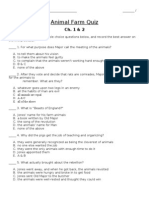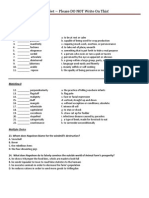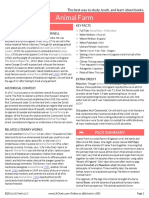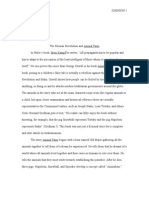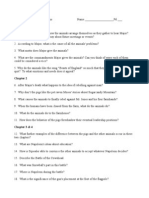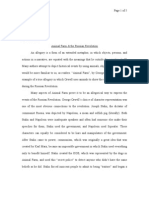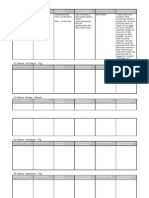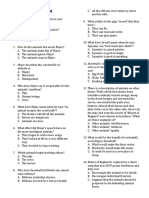Animal Farm Power Point Presentation
Animal Farm Power Point Presentation
Uploaded by
rewalCopyright:
Available Formats
Animal Farm Power Point Presentation
Animal Farm Power Point Presentation
Uploaded by
rewalOriginal Description:
Copyright
Available Formats
Share this document
Did you find this document useful?
Is this content inappropriate?
Copyright:
Available Formats
Animal Farm Power Point Presentation
Animal Farm Power Point Presentation
Uploaded by
rewalCopyright:
Available Formats
Animal
Farm
By George Orwell
Gen re:
Al le gory - Satir e - Fab le
All animals are equal, but some are more equal than others.
George Orwell
British Author & Journalist
1903-1950
Born in India
At that time India was a part of the British
Empire, and Blair's father held a post as an
agent in the Indian Civil Service.
The Blair family was not very wealthy.
They owned no property and had no
extensive investments; they were like
many middle-class English families of the
time, totally dependent on the British
Empire for their livelihood and prospects.
Noted as a novelist and critic, as well as a
political and cultural commentator
One of the most widely admired Englishlanguage essayists of the 20th century
Best known for two novels critical of
totalitarianism in general, and Stalinism in
particular:
Animal Farm
Nineteen Eighty-Four
Liberty is telling people what they do not want to hear.
19 84
The novel, published in
1949, takes place in 1984
and presents an imaginary
future where a totalitarian
state controls every aspect
of life, even people's
thoughts. The state is
ruled by a group known as
the Party; its leader and
dictator is Big Brother.
George Orwell and His Beliefs
Orwell was a person who had a reputation for standing apart
and even making a virtue of his detachment.
This outsider position often led him to oppose the crowd.
He viewed socialists, communists, and fascists as repressive
and self-serving.
He was skeptical of governments and their willingness to
forsake ideas in favor of power.
Interesting Fact:
George Orwells real name was Eric Blair.
Trivia:
What is an authors pen name called?
Why Animals?
In explaining how he came to write Animal
Farm, Orwell says he once saw a little boy
whipping a horse and later he wrote,
It struck me that if only such animals became aware
of their strength we should have no power over
them, and that men exploit animals in much the same
way as the rich exploit the [worker].
George Orwell in India
He was born in India and
spent his early years
there since his father held
a post there.
He was a lonely boy who
liked to make up stories
and talk with imaginary
companions.
As an adult, he worked
for the Imperial Police in
British occupied India.
What is Animal Farm?
A masterpiece of political satire,
Animal Farm is a tale of oppressed
individuals who long for freedom but
ultimately are corrupted by assuming
the very power that had originally
oppressed them.
The story traces the deplorable
conditions of mistreated animals who
can speak and who exhibit many
human characteristics. After extreme
negligence by their owner, the
animals revolt and expel Mr. Jones
and his wife from the farm.
Animal Farm is generally viewed as
Orwell's critique of the communist
system in the former Soviet Union.
Inter es ti ng Fact : Orwell initi ally stru ggl ed
to fin d a pu bli sh er for Anima l Fa rm .
Significance Today
But why now that Soviet Communism
has fallen and the Cold War is over
does An imal Far m deserve our
attention? The answer lies in the power
of allegory. Allegorical fables, because
they require us to make comparisons
and connections, can be meaningful to
any reader in any historical period. The
story of An imal Far m will always
have lessons to teach us about the
ways that people abuse power and
manipulate others.
Orwell's chilling story of the betrayal of
idealism through tyranny and
corruption is as fresh and relevant
today as when it was first published in
1945.
Childrens Book? No!
Af ter Ani mal Far m wa s pub lish ed in 1945 , George
Or we ll disco ver ed wi th horror tha t b ookse ll er s we re
pl aci ng his no vel on ch il dre ns shelv es . Acco rdin g to
hi s house ke epe r, he b egan trav el in g from bo okst ore
to bo okst ore r equ esti ng th at the book be sh el ved
wit h ad ult wo rks. This du al ide nti ty as child ren s
st ory and ad ult sa tir e has s taye d wi th Orwe ll s
no vel for mo re th an sixt y ye ar s.
The Fable
The fable is one of the oldest
literary forms - older than the novel
or the short story.
A fable is usually short and conveys
a clear moral or message.
The earliest fables date back to 6th
Century Greece.
The author of these fables, Aesop,
used animal characters to stand for
human "types.
For example, a fox character might
embody the human characteristics of
cunning and cleverness.
Animal Fables
The most popular animal fables of
the 20th Century are the Jus t So
Stories (1902) written by Rudyard
Kipling.
Kipling's fables were adapted by
Disney in the movie Th e Jun gle
Book .
Orwell admired Kipling, and the
Jus t So St orie s would seem to
have influenced the form of
An imal Far m .
Characterization in Fables
We already know that a fab le is a narration intended to
enforce a useful truth. Fables have two important
characteristics.
First, they teach a moral or lesson.
Second, the characters are most frequently animals.
These animal characters often function as a device to point
out the follies of humankind.
Allegory
Most fables have two levels of meaning. On the surface, the
fable is about animals. But on a second level, the animals
stand for types of people or ideas. The way the animals
interact and the way the plot unfolds says something about
the nature of people or the value of ideas. Any type of
fiction that has two levels of meaning in this way is called an
al le go ry .
Allegory (contd)
Boxer
An ima l Fa rm is strongly allegorical.
On the first level, the story about
the animals is very moving. You can
be upset when Boxer is taken away
by the horse slaughterer without
being too aware of what he stands
for. But at the same time, each of
the animals does serve as a symbol.
The story's second level involves the
careful critique Orwell constructed to
comment on Soviet Russia.
Allegory (contd)
The pigs not only
represent specific
tyrannical soviet leaders.
they could also be
symbols for tyranny more
broadly: their qualities
are therefore not simply
the historical
characteristics of a set of
actual men but are the
qualities of all leaders
who rely on repression
and manipulation.
Squealer, Snowball, & Napoleon
Satire
In a sat ire , the writer
attacks a serious issue by
presenting it in a ridiculous
light or otherwise poking fun
at it. Orwell uses satire to
expose what he saw as the
myth of Soviet socialism.
Thus, the novel tells a story
that people of all ages can
understand, but it also tells
us a second story that of
the real-life revolution.
Soviet Coat of Arms
Irony
Ir ony results when there is a
disparity between what an
audience would expect and what
really happens.
Orwell uses a particular type of
irony dramatic irony.
Snowball below the commandments.
The audience can recognize that
the pigs are decadent and corrupt
without the narrator pointing these
things out directly.
The other characters (the animals)
cannot see that the pigs are
corrupt.
Napoleon overindulging himself.
When History and Literature Merge
Critics often consider Animal Farm to
be an allegory of the Russian
Revolution.
In the early 1900s, Russias Czar
Nicholas II faced a very unhappy
population.
Many Russian peasants were
struggling to survive under an
oppressive government.
By 1917, a revolution began.
In two major battles, the Czars
government was overthrown and
replaced by the leadership of Vladimir
Lenin.
When Lenin died in 1924, his former
colleagues Leon Trotsky and Joseph
Stalin struggled for power.
Stalin won the battle, and he
deported Trotsky into permanent
exile.
Czar Nicholas II
Vladimir Lenin
Joseph Stalin
Leon Trotsky
Joseph Stalin
Once in power, Stalin began, with
utmost urgency to move the Soviet
Union into the modern industrial age.
His government seized land in order to
create collective farms and modernize
Soviet industry.
Many peasants refused to give up their
land, so to counter resistance Stalin
used vicious military tactics.
Rigged trials led to executions of an
estimated 20 million government
officials and ordinary citizens.
The government controlled the flow and
content of information to the people,
and all but outlawed churches.
Joseph Stalin
Napoleon = Joseph Stalin
Napoleon
Boar who leads the rebellion against
Farmer Jones
After the rebellions success, he
systematically begins to control all
aspects of the farm until he is an
undisputed tyrant.
Joseph Stain
The communist dictator of the Soviet
Union from 1922-1953 who killed all
who opposed him.
He loved power and used the KGB
(secret police) to enforce his ruthless,
corrupt antics.
Farmer Jones = Czar Nicholas II
Farmer Jones
The irresponsible owner of the
farm
Lets his animals starve and beats
them with a whip
Sometimes shows random
kindness
Czar Nicholas II
Weak Russian leader during the
early 1900s
Often cruel and brutal to his
subjects
Displays isolated kindness
Snowball = Leon Trotsky
Snowball
Boar who becomes one of the
rebellions most valuable leaders.
After drawing complicated plans
for the construction of a windmill,
he is chased off of the farm
forever by Napoleons dogs and
thereafter used as a scapegoat for
the animals troubles.
Leon Trotsky
A pure communist leader who was
influenced by the teachings of Karl
Marx.
He wanted to improve life for
people in Russia, but was driven
away by Lenins KGB.
Old Major = Karl Marx
Old Major
An old boar whose speech about
the evils perpetrated by humans
rouses the animals into rebelling.
His philosophy concerning the
tyranny of Man is named
Animalism.
He teaches the animals the song
Beasts of England
Dies before revolution
Karl Marx
The inventor of communism
Wants to unite the working class
to overthrow the government.
Dies before the Russian
Revolution
Who is Karl Marx?
Many of the ideals behind the Soviet
revolution were based on the writings
and teachings of a German intellectual
named Karl Marx.
Marx believed that societies are divided
into two segments:
a working class (creates all the products)
an owner class (enjoys all the benefits)
This class division leads to inequality and
oppression of the working class.
Marxs objective was to create a classless
society in which the work is shared by all
for the benefit of all, and he believed
revolution was the way to achieve this
goal.
Squealer & Boxer
Squ ea ler
A big mouth pig who becomes Napoleons
mouthpiece. He manipulates the animals
thoughts through the use of hollow, yet
convincing rhetoric.
Represents the propaganda department that
worked to support Stalins image through lies.
Boxer
A dedicated but dimwitted horse who aids in
the building of the windmill but is sold to a
glue-boiler after collapsing from exhaustion.
Represents the dedicated, but tricked
communist supporters of Stalin who stayed
loyal even after it was obvious Stalin was a
tyrant.
Squealer
Boxer
Jessie & Moses
Jes sie
The farm's sheepdog, she keeps tabs
on the pigs and is among the first to
suspect that something is wrong at
Animal Farm.
Mos es
A tame raven and sometimes-pet of
Jones who tells the animals stories
about a paradise called Sugarcandy
Mountain.
Moses represents religion. Stalin used
religious principles to influence people
to work and to avoid revolt.
Jessie
Moses
Animalism = Communism
Animalism
Taught my Old Major
No rich, but no poor
Better life for workers
All animals are equal
Everyone owns the
farm
Communism
Invented by Karl Marx
All people are equal
Government owns
everything
People own the
government
Animal Farm Revolution
= Russian Revolution
Animal Farm Revolution
Was supposed to make life
better for all, but . . .
Life was worse at the end.
The leaders became the
same as, or worse than the
other farmers (humans) they
rebelled against.
Russian Revolution
Was supposed to fix the
problems created by the
Czar, but . . .
Life was even worse after
the revolution.
Stalin made the Czar look
like a nice guy.
You might also like
- Animal Farm Final TestDocument12 pagesAnimal Farm Final TestFlavia Pacheco50% (2)
- Animal Farm Unit TestDocument3 pagesAnimal Farm Unit TestMary A Kudla100% (1)
- Animal Farm CharactersDocument2 pagesAnimal Farm Charactersapi-276638188100% (7)
- Animal Farm Study GuideDocument47 pagesAnimal Farm Study Guideeneko23100% (1)
- Animal Farm Quiz: Directions: Read The Multiple Choice Questions Below, and Record The Best Answer OnDocument2 pagesAnimal Farm Quiz: Directions: Read The Multiple Choice Questions Below, and Record The Best Answer Onkischuk67% (3)
- Analysis - Animal Farm by BloomDocument102 pagesAnalysis - Animal Farm by Bloomcaritadeangel55100% (4)
- Symbolism in Animal FarmDocument1 pageSymbolism in Animal FarmAndreea Liliana100% (3)
- Animal Farm TBDocument52 pagesAnimal Farm TBEvie75% (4)
- Animal Farm PDFDocument26 pagesAnimal Farm PDFYaser100% (7)
- Animal Farm Test Preparation Sample PagesDocument43 pagesAnimal Farm Test Preparation Sample PagesFatima100% (6)
- Animal Farm QuestionsDocument5 pagesAnimal Farm QuestionsCoachBindel100% (1)
- Timeline Animal Farm FinalDocument11 pagesTimeline Animal Farm Finalapi-272844832No ratings yet
- Animal Farm Quiz CH 5-7Document3 pagesAnimal Farm Quiz CH 5-7jeancaligirl3100% (3)
- Animal Farm Major Characters and SummaryDocument15 pagesAnimal Farm Major Characters and Summaryr_borresNo ratings yet
- Animal Farm Reading GuideDocument4 pagesAnimal Farm Reading Guidemarqrome100% (2)
- Animal Farm VocabularyDocument5 pagesAnimal Farm VocabularyMicaela DavisNo ratings yet
- Animal Farm QuestionsDocument5 pagesAnimal Farm QuestionsCoachBindel100% (1)
- Animal Farm LitChartDocument18 pagesAnimal Farm LitChartKadeise Hendrickson100% (3)
- Critical Review of Animal FarmDocument8 pagesCritical Review of Animal Farmrheney adindaaNo ratings yet
- The Russian Revolution and Animal FarmDocument6 pagesThe Russian Revolution and Animal FarmJulie Johnson100% (15)
- Animal Farm Animal AnalysisDocument4 pagesAnimal Farm Animal AnalysisMariela Zayas100% (1)
- Animal Farm Project PDFDocument48 pagesAnimal Farm Project PDFsree suba100% (1)
- Animal FarmDocument5 pagesAnimal FarmAntariksh Pratap Singh100% (2)
- Animal Farm Study GuideDocument5 pagesAnimal Farm Study GuideLukas Howe100% (4)
- Character Profiles Animal FarmDocument13 pagesCharacter Profiles Animal Farmar44100% (1)
- Animal Farm NotesDocument13 pagesAnimal Farm NotesJoseph Lin100% (1)
- Animal Farm Study QuestionsDocument3 pagesAnimal Farm Study Questionsmarqrome80% (10)
- Animal Farm WordDocument34 pagesAnimal Farm WordK M100% (3)
- Animal FarmDocument3 pagesAnimal FarmkalasantyNo ratings yet
- Animal Farm Chapter QuestionsDocument3 pagesAnimal Farm Chapter Questionskcafaro59100% (1)
- Animal Farm - PowerDocument22 pagesAnimal Farm - PowerPrabhjeet Singh100% (1)
- Animal Farm Satire NotesDocument15 pagesAnimal Farm Satire Notesapi-292720994No ratings yet
- Teachers Notes-Questions, Intro's, and ActivitiesDocument14 pagesTeachers Notes-Questions, Intro's, and ActivitiesBrenna100% (2)
- Animal Farm QuestionsDocument3 pagesAnimal Farm QuestionsGirlhappy Romy0% (1)
- The Animal FarmDocument3 pagesThe Animal FarmMike Llamas25% (4)
- Animal Farm Study Guide (Overview)Document14 pagesAnimal Farm Study Guide (Overview)aliabidi100% (3)
- Animal Farm vs. Russian RevolutionDocument5 pagesAnimal Farm vs. Russian Revolutionx0xdramatic121No ratings yet
- Animal Farm: Study GuideDocument14 pagesAnimal Farm: Study GuideAhmed Samir100% (2)
- Animal Farm PDFDocument26 pagesAnimal Farm PDFDhanyaa Nair100% (3)
- Animal Farm Characters: 1. NapoleanDocument7 pagesAnimal Farm Characters: 1. NapoleanHareesh Triple H100% (1)
- Propaganda Animal FarmDocument4 pagesPropaganda Animal FarmMina Minerva100% (1)
- Animalfarmpenguin Readers GuideDocument15 pagesAnimalfarmpenguin Readers Guideapi-194333853100% (2)
- SN Themes, Motifs and Symbols of Animal Farm by George OrwellDocument4 pagesSN Themes, Motifs and Symbols of Animal Farm by George Orwell10nov1964No ratings yet
- Class Struggle in Animal FarmDocument4 pagesClass Struggle in Animal Farmapi-348807701No ratings yet
- Animal Farm QuestionsDocument5 pagesAnimal Farm QuestionsFranco Daniel Martinez100% (1)
- Animal Farm Study GuideDocument37 pagesAnimal Farm Study Guideyinniemouse100% (2)
- Critical-Analysis ANIMAL FARMDocument15 pagesCritical-Analysis ANIMAL FARMSEYALIERY COZENS67% (3)
- Animal Farm Characters TemplateDocument6 pagesAnimal Farm Characters TemplatesarahmeratNo ratings yet
- Animal FarmDocument6 pagesAnimal FarmRangothri Sreenivasa SubramanyamNo ratings yet
- Major Themes in Animal FarmDocument3 pagesMajor Themes in Animal FarmIVy ViOlet ThOrnNo ratings yet
- Animal Farm Vocabulary ListDocument1 pageAnimal Farm Vocabulary ListyoungbloodfamilyNo ratings yet
- Af SG With AnswersDocument7 pagesAf SG With AnswersBeaNo ratings yet
- Animal FarmDocument6 pagesAnimal FarmPowerPoints Galore50% (6)
- ANIMAL FARM ACTIVITY PACK Za Objavo PDFDocument69 pagesANIMAL FARM ACTIVITY PACK Za Objavo PDFNguyen Vuong Minh Thu B180851383% (6)
- Animal FarmDocument4 pagesAnimal FarmPrem Kumar100% (1)
- Animal FarmDocument18 pagesAnimal FarmJuan Antonio100% (2)
- Animal Farm ReviewDocument41 pagesAnimal Farm Reviewtracy zvenhamo100% (1)
- Animal Farm Background InformationDocument8 pagesAnimal Farm Background Informationbdwentz9435100% (15)
- Animal Farm Xs10Document4 pagesAnimal Farm Xs10CarminaCarilloNo ratings yet
- Animal Farm PowerPointDocument29 pagesAnimal Farm PowerPointLisa Ward100% (1)
- Animal FarmDocument4 pagesAnimal Farmlolicon1No ratings yet
- AllegoryDocument4 pagesAllegoryuptagrafftreneauNo ratings yet
- A Teacher in China Learns The Limits of Free ExpressionDocument49 pagesA Teacher in China Learns The Limits of Free ExpressionAl GNo ratings yet
- Unit Plan Animal FarmDocument3 pagesUnit Plan Animal Farmapi-552410496100% (1)
- Final 2020Document3 pagesFinal 2020Absar SiddiquiNo ratings yet
- Compare Contrast Essay 11-14-16Document8 pagesCompare Contrast Essay 11-14-16api-349087538No ratings yet
- Animal Farm ArticleDocument13 pagesAnimal Farm ArticleHamdi TuanNo ratings yet
- English Book ClubDocument10 pagesEnglish Book ClubJunseo KangNo ratings yet
- Animal Farm Power Point PresentationDocument28 pagesAnimal Farm Power Point Presentationrewal100% (7)
- Animal Farm Revision - Comprehension Q and A-1Document4 pagesAnimal Farm Revision - Comprehension Q and A-1MishyaafNo ratings yet
- Event Analysis of The Russian Revolution To Animal FarmDocument3 pagesEvent Analysis of The Russian Revolution To Animal Farmapi-614865439No ratings yet
- Conformity SpeechDocument2 pagesConformity SpeechJack Ault100% (1)
- English LITERATURE 8702/1M: Paper 1M Modern Prose or DramaDocument36 pagesEnglish LITERATURE 8702/1M: Paper 1M Modern Prose or DramaT SolomonNo ratings yet
- How To Edit EssayDocument8 pagesHow To Edit Essayibnorvbaf100% (2)
- Animal Farm Symbolism Thesis StatementDocument8 pagesAnimal Farm Symbolism Thesis Statementafkololop100% (2)
- Setting and Characters in Animal FarmDocument32 pagesSetting and Characters in Animal FarmShini Matthews-Frazer100% (1)
- ISIProseDocument17 pagesISIProseSyafiq GumilangNo ratings yet
- Animal Farm Essay Questions 2024Document5 pagesAnimal Farm Essay Questions 2024lenzi.ikkiNo ratings yet
- Literary DevicesDocument13 pagesLiterary DevicesMagaLiita FerreroNo ratings yet
- Animal Farm Notes 2024 - M MundetaDocument5 pagesAnimal Farm Notes 2024 - M MundetaMiguel MNo ratings yet
- Animal Farm EssayDocument6 pagesAnimal Farm EssayFrancesca ElizabethNo ratings yet
- Slp2 21st Century LiteratureDocument59 pagesSlp2 21st Century Literatureariza baylosisNo ratings yet
- Plot Animal FarmDocument2 pagesPlot Animal FarmDenisa DinuNo ratings yet
- Eng B - Animal FarmDocument2 pagesEng B - Animal FarmNathefa LayneNo ratings yet
- George Orwell: Animal FarmDocument6 pagesGeorge Orwell: Animal Farmjesus davidNo ratings yet
- Ebs 158sw - Prose FictionDocument60 pagesEbs 158sw - Prose Fictiontabithaahadzi27No ratings yet
- F.C.E TIPS & PRACTICEDocument22 pagesF.C.E TIPS & PRACTICEAlina TeranNo ratings yet




